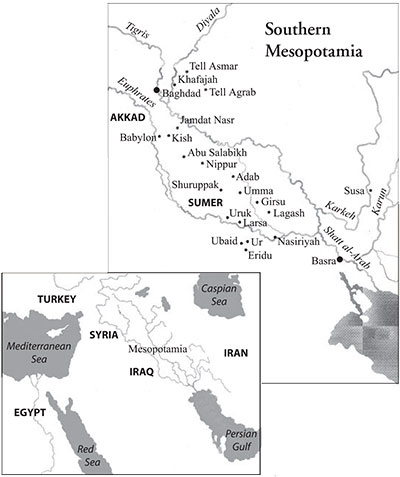
Almost 4,000 years ago, a young scribe sat in a sunny courtyard in the ancient city of Nippur holding a small disk of clay. He stared closely at the signs carefully written for him by his teacher before taking up his stylus and quickly copying the line: sizu ima si baninsa. “She guided your finger on the clay.”
The slight shakiness of his hand showed that he still needed more guidance from Nisaba, goddess of writing, but the little disk was saved from the recycling bucket anyway, and eventually set aside or lost, allowing it to survive the millennia to be discovered by people from an age which no longer remembered so much as the name of the language written by the teacher and the student who created it. Little did the scribe know that his writing exercise would someday help scholars decipher this ancient language (now called ‘Sumerian’) and lead to the creation of a modern dictionary that would open our eyes on the world in which he wrote and lived.
The Decipherment of Cuneiform
While the scribe’s exercise lay buried in the ruin mounds of Nippur in southern Mesopotamia, the world turned. In the 17th century AD, European travelers to the Middle East began to mention strange triangular writings found on stones amid the great ruin mounds of what is now Iraq. Local consular officials began to dig in the mounds and by the mid-1800s they were uncovering vast riches of artworks and tens of thousands of small, pillow-shaped pieces of clay, most of them no more than four or five inches tall and a few inches wide, covered with the characteristic tightly written and impenetrable triangular script.
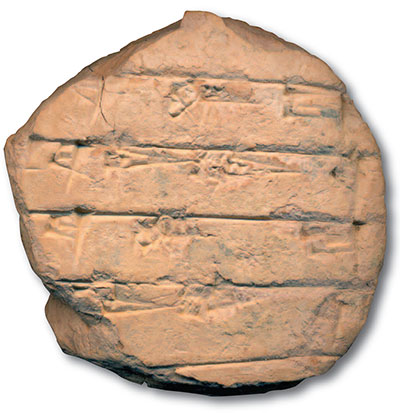
Decipherment was not easy, but after decades of laborious effort punctuated by dramatic breakthroughs, Henry Fox Talbot, a highly talented amateur English decipherer, proposed in 1857 that the Royal Asiatic Society of Great Britain stage a competition to evaluate whether the cuneiform—triangle shaped—script had in fact been cracked. Talbot and three other top analysts of the day—Edward Hincks in Ireland, Henry Creswick Rawlinson in England, and Jules Oppert in France—each received a copy of the same previously un-deciphered text. Their attempts at interpretation were then sent under seal to the Society. Their agreement with each other was so substantial that there could be no doubt that Akkadian cuneiform had begun to yield up its secrets.
Yet the mysteries did not end there for amidst the tens of thousands of texts arriving at the British Museum from the royal libraries of the northern Mesopotamian site of Nineveh, were many which were clearly written in two languages. One was Akkadian, the newly deciphered Semitic tongue; but what was the other?
Debate raged for 50 more years. Some scholars argued early on that this second tongue was, in fact, a full-fledged language, even if they differed on what its name should be. Others claimed that it was not a language in its own right, but a kind of priestly code, used to obfuscate secret rites and texts to prevent their being read by the uninitiated. Not until the year 1900 did the last arguments die down about the identity of what we now call Sumerian. By then, the little disk from Nippur had been found by an expedition from the University of Pennsylvania, and had made its way, albeit somewhat battered and abraded, to its current home in the Babylonian Section of the University of Pennsylvania Museum of Archaeology and Anthropology.
The writing exercise arrived with about 20,000 other tablets excavated by a Penn team between 1888 and 1892. Here it joined its siblings from the ancient schools of Nippur. First written around the year 1730 BC, the one-liner from a hymn to king Lipit-Eshtar formed part of the middle stages of a long curricular sequence which is well-understood today thanks to recent work on the collections of the Penn Museum and other related materials.
Our scribe would have begun with the first tentative steps in simply making wedges by pressing the sharpened reed stylus—a tool not unlike a quill-pen in shape—into clay. Following the outlines sketched by the teacher in the sand, the scribe learned how to juxtapose wedges in common combinations, then to make meaningful signs. Syllables at first: [see Fig. 1]
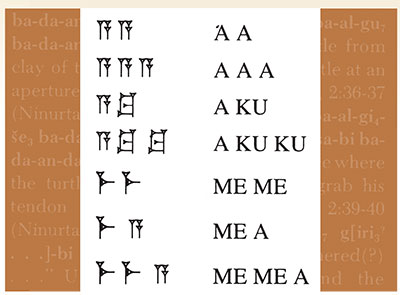
Simple signs repeated until the hand could make them without conscious thought. Then the repertoire of syllables required to write words as a sequence of sounds was mastered: [see Fig. 2]

But the 80 or so syllables needed for basic spelling was inadequate for the scribe’s ultimate goal—Sumerian. This alien tongue, already strange and ancient by the time of our young scholar, was written in a mixture of syllables and ideograms—cuneiform signs that could signify any one of a collection of words which usually shared some conceptual or phonetic relationship. The first introduction followed a conceptual system: words for types of wood, objects made of wood.
Weeks and months of study passed as the scribe internalized over 800 entries for the wood list, then moved on to the list of animals. Day after day, following the teacher’s exercise on the scratch pad of a large exercise tablet and writing again!—a longer extract from a text already committed to memory. Tablet after tablet, formed, written, and then returned to the bucket of water to be recycled. List after list not just words, but personal names, too, combinations of words such as Urim ki dug, “(the city) Ur (is) a good place,” and simple literary texts like the line from the royal hymn inscribed on the little disk of clay.
By now, large amounts of the requisite vocabulary had been learned, and a new list with a different system was added to the scribe’s daily assignments. Organized this time by the sign, the new twist enumerated the pronunciations of the different words each sign could represent. Written in a combination of simple syllables and the ancient ideograms, this sign list (called “Ea” by modern scholars) repeats the ideogram several times, with a different pronunciation written beside it in syllables: [see Fig. 3]

Advancing still further, the scribe added more complicated literary texts—hymns to gods and kings, tales of the hero Gilgamesh—to the repertoire, as well as one more development in the tradition of lists.
Building on the sign list, Ea, another column was supplied, also in syllabic signs. But this time, the column was in the scribe’s own language, Akkadian, and the glosses gave not pronunciation but the translation of the Sumerian word. After years of study, the scribe whose finger Nisaba guided on the clay was writing one of the world’s first dictionaries: [see Fig. 4]
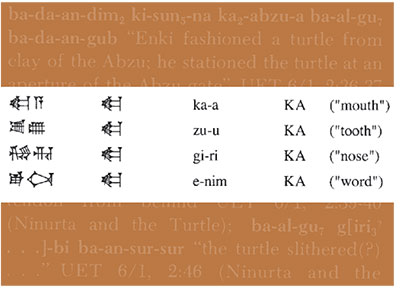
The Pennsylvania Sumerian Dictionary
It was not until 1938 that Samuel Noah Kramer, the Curator of the Babylonian Section at the Museum until 1965, published his edition of a Sumerian tale he called “Gilgamesh and the Huluppu-tree.” Kramer traveled the world, reconstructing Sumerian literature from the overlapping—and often joining—fragments of the Nippur tablets, which had ended up not only in Philadelphia but also in Jena in Germany and Istanbul in Turkey. In a very real sense, our understanding of Sumerian literature—the literature which forms the basis for the Pennsylvania Sumerian Dictionary (PSD)—begins with Kramer and the long string of publications based on his work.
While Kramer was exploring the vast holdings of the museums, Adam Falkenstein, working in Heidelberg in Germany, published in 1959 a landmark study of Sumerian court documents which included a glossary of Sumerian terms—no dictionary, but a huge step nevertheless. A few years later, in 1966, Åke Sjöberg, a student of Falkenstein’s, arrived at the Penn Museum, his teacher’s insistence on including glossaries in books still ringing in his ears. Sjöberg duly followed this principle in both of his early works, but was never satisfied that this was enough.
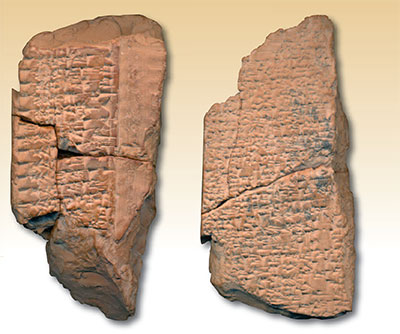
[right]The reverse of the same tablet contains a royal hymn from the scribal curriculum (CBS 10988).
A substantial factor in the success of the project and its funding has been the presence in the Babylonian Section of the schoolbooks of yesteryear—the word lists and literary texts which can be consulted firsthand whenever a question of reading or interpretation arises. PSD is founded on the works of the teachers and students of 18th century BC Nippur.
The task facing the project team in those far-off days was immense. Sumerian is a language isolate, with no known relatives living or dead. Most Sumerian texts were unpublished or lacked a modern edition and translation; some scholars did not even believe it was possible to write a dictionary of Sumerian at the time. Undaunted, the team mapped out an approach modeled on that of the Chicago Assyrian Dictionary, where Leichty had worked before coming to Penn.
Texts were indexed and the words entered on file cards which formed the basis for exhaustive articles about each word. A volume was planned for each letter, with some volumes being divided into several parts. The team began with the “B” volume, because it provided a manageably small starting point and “B” duly appeared in 1984 to worldwide fanfare. Then the work began on the “A” volume, a grueling task which would result in three published volumes over a period of 10 years, and the completion of a draft manuscript of the final fourth part. This fourth part was never published, however, for the world turned again, and the long-term plans of a dictionary, which would take at least another several decades to complete, were forced to change with the times.
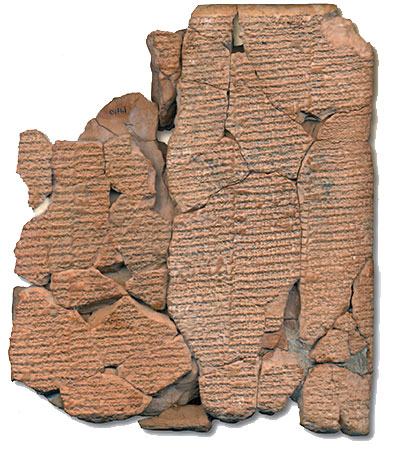
In 1991, I came to work on the dictionary project for a year and never left. My timing coincided with the explosive growth of the internet in the early 1990s. This growth, with its new values of immediacy and massively greater potential for long-distance collaborations, changed the face of scholarship and changed the context within which PSD operated. The notion that the world would wait another 40 or 50 years for the publication of a complete dictionary came into question. At the same time, the new digital world offered the possibility of creating a new kind of dictionary—one which was deeply and richly linked to the corpus of texts which was its basis, and which would provide scholars everywhere with a freely available research tool that could enable them to push back the boundaries of Sumerian lexicography in new ways—an e-dictionary.
Today, the electronic PSD (ePSD; http://psd.museum.upenn.edu) is well‑advanced in fulfilling that potential. The dictionary comprises three main parts: (1) the lexicon (or word list which is at its heart); (2) the corpus of Sumerian texts to which the lexicon is linked; and (3) the global catalogue of the cuneiform corpus (maintained by Bob Englund and the Cuneiform Digital Library Initiative http://cdli.ucla.edu), which provides information on the texts (metadata), which allows us to create lists of attestations based on the times, places, and text-types for which any given meaning of any given word is attested. A variety of computer programs helps create links from the lexicon to the individual words in the corpus, and the results are reviewed by project staff and our collaborators, including Niek Veldhuis of the University of California, Berkeley, who manages a project devoted to the ancient word lists (http://cdl.museum.upenn.edu/dcclt). Once the links are established, they persist; when texts change, as they sometimes do, the links are easy and quick to correct, and the dictionary maintains its integrity.


The ePSD provides a flexible and informative interface to over 50,000 Sumerian texts which have been drawn from all periods and genres. As a result, it has a fair claim to being complete—which is not to say that new words will not come to light or that new interpretations will not arise. Users visiting the site can search the dictionary in Sumerian or in English to select, for example, all the terms for “sheep.” After choosing an article of interest, a click brings up a list of all of the instances of the chosen term—the list can be narrowed by spelling or by time-period or by the sense in which the word is used. The instances can be presented according to chronological order or by the place or genre associated with the text. Another click displays the full context of the citation and, where available, photographs or drawings of the tablet can also be reached. While much incremental improvement remains to be made, the ePSD as a research tool is already fully functional. (Expedition’s readers are encouraged to play with the dictionary online, since it is hard to describe in print.)
The ePSD is not finished, though—indeed, in some senses it never will be. For one thing, we recognize the need for much more translation of texts to increase the value of the dictionary for users who are not Sumerian specialists (for some kinds of texts we will do this computationally). For another, we have only ever conceived of the completion of this phase of the work as the creation of an essential tool which can be maintained in perpetuity as new texts, new words, new interpretations become available. In this sense, we conceive of the Sumerian dictionary as a process rather than a product.
Building on this tool, the next task for the project team will be to begin applying the human layer to the computational work—real lexicography requires long, deep thought and analysis of not only individual terms but groups of related words—for example, the terminology relating to beer-production. Such groups of words, many of which may be opaque to us at present, must be considered together because their interpretation is mutually informative.
Finally, as the ePSD has matured its core technology has been generalized. The same tools can now be used to create corpus-based dictionaries of other languages, and we are already working with several projects worldwide in pursuit of this end.
Much remains to be done. To borrow a turn of phrase from a famous statesman: we will not say that this is the end; nor will we say that this is the beginning of the end; but we can say that this is the end of the beginning. May Nisaba guide our fingers on the keyboard!
